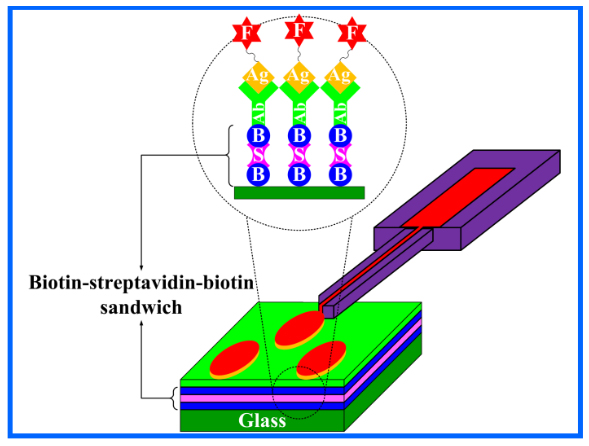
Coupling Chemistry for Surface Immobilization in Scanning Probe Lithography
-
Author:
Mahdi Dadfar
-
Source:
Dissertation, Karlsruher Institut für Technologie (KIT) (2019)
- Date: 2019
-
Functionalization of surfaces and materials through the covalent attachment of organic monolayers has many applications in chemical/biological sensing, drug delivery, selective gas separation, cancer detection, etc. In this regard, click chemistry reactions, especially those that require no metal catalyst, are powerful candidates. This project focuses on the functionalization of glass and diamond surfaces via different click reactions with the purpose of creating microscale patterns for sensing applications. Before functionalization, the surfaces were modified using attachment of suitable functional groups through esterification or silanization techniques. The glass surfaces were divided into three groups. First groups were modified with dibenzocyclooctyne-acid (DBCO-acid), a cyclooctyne with a carboxyl group (DBCO-terminated glasses). Second groups were modified with (3-mercaptopropyl)trimethoxysilane (MPTMS) which is a mercaptosilane (thiol-terminated glasses). And finally, third groups were modified with (3-glycidyloxypropyl)trimethoxysilane (GPTMS) which is a glycidoxysilane (epoxy- terminated glasses). Then, in the distinct experiments, all glass surfaces were functionalized via microchannel cantilevers spotting (µCS) with different fluorescent and non-fluorescent inks: DBCO-terminated glass surfaces with inks containing azide or thiol groups, thiol-terminated glass surfaces with inks containing maleimide or DBCO groups and epoxy-terminated glass surfaces with inks containing thiol, amine or azide groups. Experiments with different fluorophores showed that all routes were successful in coupling functional moieties to the surface in a short time and low temperature. Also, from these experiments, optimal reaction conditions were determined. The feasibility of these routes and micropattern fabricated by them in biomedical and biological applications was examined through protein binding experiments. Comparing the streptavidin binding experiments for different biotin carrying spot arrays (biotin- azide and biotin-thiol on DBCO-terminated, biotin-maleimide and biotin-DBCO on thiol- terminated glass surfaces and biotin-thiol, biotin-amine and biotin-azide on epoxy-terminated glass surfaces) revealed the higher surface density of immobilized biotin for biotin-maleimide on the thiol-terminated surface and biotin-amine on the epoxy-terminated surface which the former is a thiol-ene Michael addition (TEMA) reaction and the latter is a ring opening of epoxy by amine. Considering the obtained results from functionalization of different glass surfaces with different fluorescent and non-fluorescent inks, sensitive fluorescent immunosensors for Alpha- fetoprotein (AFP) detection were designed and fabricate. AFP is the most commonly biomarker for early screening and diagnosis of hepatocellular carcinoma (HCC). In assembling these immunosensors, three techniques including click chemistry, biotin-streptavidin-biotin sandwich- type strategy and antigen-antibody interaction were combined. Finally, the experiments performed on the glass surfaces were repeated on the DBCO-, thiol- and epoxy-terminated diamond surfaces as diamond is used as an excellent transducer in optical sensor. The obtained achievements and results from this study are applicable in design and fabricating of biosensors, appropriate for protein detection and other biomedical/biological applications.
